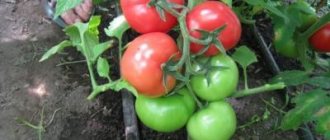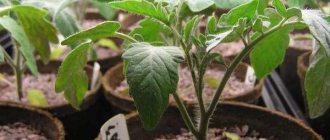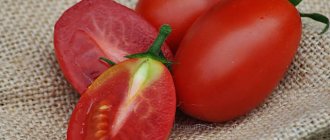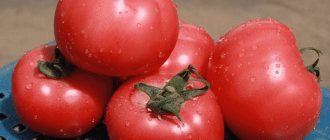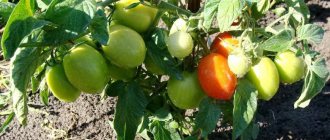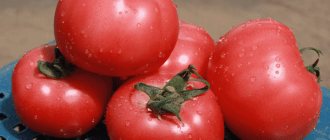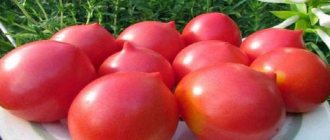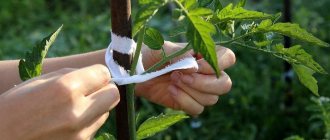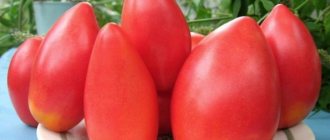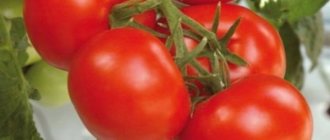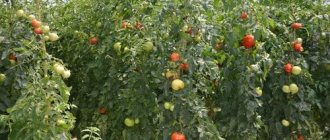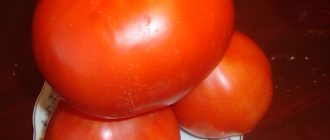Slavyanka - pink tall tomatoes, suitable for growing in dachas and small farms in the open air and under film covers. The fruits can be eaten fresh or used for processing.
| Height | Landing location | Ripening time | Fruit color | Fruit size | Origin | Fruit shape |
| Tall | Open ground | Mid-early | Pink | Small | Variety | With spout |
Growing tomatoes
“Lyana pink” is a universally grown tomato. It can be cultivated in a greenhouse and open ground, in seedlings and without seedlings, from purchased and independently collected seeds.
How to prepare seeds?
Seeds require complete pre-sowing preparation:
- Rejection. Damaged, moldy or unevenly colored seeds are not allowed for planting;
- Disinfection in antiseptic (weak solution of potassium permanganate or hydrogen peroxide);
- 30-minute exposure to growth stimulants (Kornevin, Zircon, Epin);
IMPORTANT: Pre-sowing treatment must be carried out under sterile conditions: containers and equipment must be treated with chlorine solution, manipulations must be carried out with disposable gloves. In addition, the soil used for sowing must be preheated in the oven to 60*C
Soaking in melt water for 12-24 hours.
Properly prepared seeds are characterized by increased germination (up to 90%), accelerated growth rates (the growing season is 3-5 days shorter) and higher yield.
Sowing seed material
Sowing is carried out on the 20th of March - early April - approximately 45-55 days before planting in a permanent place
When choosing a sowing date, it is necessary to take into account the climatic zone, solar activity (for normal growing season, seedlings need at least 12 hours of light per day) and the moment of return frosts - it is important that the plants are not exposed to sudden temperature changes immediately after planting
The usual sowing order is:
- Distribute the seeds in the soil using the square-cluster method at intervals of 2 cm and at a depth of no more than 1 cm;
- Pour plenty of warm water and cover with film;
- After the first shoots appear, remove the shelter and subsequently grow the plants at a temperature of 22-24*C;
- Picking is carried out after unfolding the second sheet.
Young plants need constant moisture and periodic feeding (every 7-14 days). At home, seedlings are fed with complex fertilizers such as “Fertika Lux”. When growing without seedlings, you can use organic matter: 10% mullein solution, 5% bird droppings solution, 20% nettle infusion.
Rules for planting seedlings
Two weeks before planting, seed hardening begins. To do this, the seedlings are placed outside: first for 1-2 hours, then for 2-3, and so gradually increase their stay in the open air to around the clock.
In parallel with hardening off the plants, they are preparing the beds:
- Remove weeds and dig to a depth of 10-15 cm;
- Fertilizers are applied: 2 buckets of humus per 1 sq.m, or complex products - “Biohumus”, “Biomaster” or “Gumi-Omi”.
The plants are transferred with a ball of earth, trying not to affect the root system, and placed in the planting hole so that the bottom leaf is 4-5 cm from the ground.
When planting plants, adhere to the following scheme:
- Distance between plants – 40 cm;
- The interval between rows is 50 cm;
- Recommended planting density is 4-6 bushes per 1 sq.m.
Planting tomato seedlings in the ground
To sow tomatoes, you must use
: plastic containers, seedling cassettes, etc., which need to be disinfected before sowing. Any containers must have special drainage holes at the bottom, otherwise the plants will be susceptible to disease
. Before starting sowing, it is necessary to ensure good
, regular temperature and air ventilation.
Obtaining a high yield of tomatoes largely depends on the timely and high-quality planting of hardened seedlings in the ground.
It is necessary to plant tomatoes in the first ten days of June, and only after the danger of frost has passed and warm weather has completely established. Both in ridges and on a flat surface, plants must be placed in rows, with a distance between them of 30-40 cm, between rows - 30-50 cm.
Slavyanka is cultivated only by seedlings. The age of the seedlings on the day of transplantation should be 55-60 days. Planting scheme - 3-4 plants per 1 sq. m. In open ground, bushes form one stem, in film shelters - two.
During the growing season, plants need to be fed three times with organic fertilizers.
Mid-season / Tall
User rating: 4/5
Early maturing / Tall
User rating: 5/5
Medium early/Tall
A gardener's paradise - the Slavic masterpiece tomato: description of the variety and tips for growing
There are varieties that achieve universal respect and love after the first planting. These tomatoes include the Slavic Masterpiece, bred by a breeder from Russia. Its success is associated with excellent taste and product characteristics, and high productivity. The fruits are intended for universal use.
| Height | Landing location | Ripening time | Fruit color | Fruit size | Origin | Fruit shape |
| Medium height | Greenhouse, Open ground | Mid-season | Reds | Average | Variety | Flat-round |
Description and characteristics of the variety
Tomato Slavic masterpiece is a medium-growing semi-determinate. The bushes are strong and powerful. Among their characteristics:
- shoot height 1.5 m;
- 5-7 tomatoes are tied on the bunches;
- the total number of clusters is left within 7-8;
- foliage and branching are moderately expressed.
- average weight 150-180 g;
- round, slightly flattened shape;
- color bright red;
- the pulp is oily, moderately juicy;
- 5-6 seed chambers, moderate number of seeds;
- the taste is dominated by sweet notes, there is a slight tomato sourness;
- The skin is strong and does not crack.
Tomatoes are used for fresh salads and slices, for preparing preserves and pickling. Juicy fruits are great for juices, ketchups, and sauces.
Advantages and disadvantages
- productivity;
- versatility of use;
- prolonged fruiting;
- disease resistance;
- endurance to low temperatures and heat;
- easy cultivation.
Minuses:
the importance of stepsoning and leading; need for fertilizing.
Features of cultivation and storage
The seedlings are transplanted into pre-fertilized beds. For 1 m2 add:
- compost bucket;
- 25 g of phosphorus-potassium composition;
- 1 cup wood ash.
What care details should be observed:
Forming into 2-3 stems. Irrigation with settled water at the root is ideal if drip irrigation is possible. Applying fertilizers 2 times a month, it is especially important to do this at the flowering and ripening stage.
Planting and care
Fertile, loose soil is prepared for planting. Mostly turf is used with the addition of compost and peat.
Sowing is carried out to a depth of 1-2 cm. Distances are kept at 3 cm. Lightly sprinkle on top and irrigate. Until the first shoots, they are kept in greenhouse conditions, where the temperature is constantly kept between 25-26 degrees. To do this, the boxes are covered with film or glass.
Planting and care
In the middle zone, seeds are sown in the first or second ten days of April. When choosing a specific day, you can follow the recommendations of the lunar calendar. Before sowing, it is enough to disinfect the seeds for 20 minutes in a weak solution of potassium permanganate and rinse with clean water.
Sowing is carried out in seedling boxes with mandatory picking into separate cups at the stage of two true leaves. When growing seedlings, maintain a temperature of 20-23 degrees.
Before planting, the bed is carefully dug up and loosened. Add a handful of chicken or cow manure and a teaspoon of superphosphate to each hole. Plants are planted straight, and if they are overgrown, they are planted obliquely and immediately secured to stakes or trellises.
Feeding schedule:
- pouring fruit on the first cluster - spraying potassium humate on the leaves (two tablespoons per 10 liters of water);
- growth of tomatoes on the second cluster - feeding with mullein or bird droppings infused in water;
- ripening of fruits on the third cluster - repeat spraying with potassium humate.
The champion variety of the beds is the Pink Supergiant tomato F1: description and cultivation features
The ideal variety is relative, but when it comes to Supergiant pink F1, even master farmers recognize its superiority. Giant fruits, wonderful taste, marketability - these are not all its bonuses. It bears fruit well in almost all regions of the country and does not require complex cultivation.
| Height | Landing location | Ripening time | Fruit color | Fruit size | Origin | Fruit shape |
| Tall | Greenhouse, Open ground | Mid-season | Pink | Large | Hybrid | Flat-round |
Description and characteristics of the variety
Tomato Supergiant pink F1 is an indeterminate tall hybrid. The bushes are strong, powerful, with vigorous vegetation. The characteristics of the shoots are as follows:
- height up to 2 m;
- pronounced branching;
- semi-spreading;
- 3-4 fruits per hand;
- the number of clusters reaches 7-8.
- average weight 600-800 g;
- the largest fruits weigh 1-2 kg;
- the pulp is moderately juicy, solid aromatic “meat”;
- few seeds, 4-6 seed chambers;
- dry matter level 5-6%;
- percentage of sugars 5%.
Prepared from tomatoes:
- summer salads and cold cuts;
- assorted and hot portions;
- juices and pastes for the winter;
- jars with preserved slices.
Advantages and disadvantages
- large fruit;
- productivity;
- disease resistance;
- good germination;
- absolute pollination;
- Tolerates drought and heat.
Minuses:
impossibility of whole-fruit canning.
Features of cultivation and storage
Select a site after the following predecessors:
To achieve maximum fruit size:
- form into 1 stem, regularly shoot;
- water abundantly, the norm for 1 bush is 7-8 liters;
- fed with phosphorus-potassium compound, saltpeter, mullein.
Planting and care
Sow to a depth of 2 cm, sprinkle with a layer of soil on top. In order for the seedlings to be strong, they adhere to agrotechnical subtleties:
- Lighting with phytolights so that the day length for seedlings is at least 12-14 hours.
- Irrigation with settled water through a spray bottle.
- Picking when there are 2-3 true leaves.
- Feeding with diluted organic solutions, adding mineral mixtures.
Tomato Pear canned - description and characteristics of the variety
Any summer resident who has grown a variety of this variety at least once can recommend it - the fruits not only have a beautiful appearance, they are tasty and easy to care for. Externally, tomatoes that are already ripe have a scarlet color, but if the fruit is still unripe, then it will be a light green color. It’s easy to guess the shape based on the name of the variety - they are pear-shaped, but the size of the fruits is small: their maximum weight can reach no more than 70 grams. Another distinctive property of tomatoes is that they have small ribs. The tomatoes are sweet and do not crack. The number of chambers with seeds is no more than 4 pieces.
Where is it recommended to grow fruits?
The variety is perfect for growing in any region, but if the climate is warm, then it is permissible to plant the seeds in open ground, but in regions where it is colder, then a greenhouse is better suited. Since 2008, the variety has been included in the State Register, which indicates the achievements of selection. The yield of tomatoes of this variety: one square meter produces about 10 kg of fruit.
general description
So, let's look at what characteristics the canned pear has:
Plants can grow up to 80 cm. The table is quite thick, but it is straight and has a very compact root system. Any gardener will tell you that you need to do the garter in a timely manner - no matter where you plan to grow tomatoes. The advantage of this variety over others is that the plant has rather large leaves, they have a juicy dark green color. They protect fruits well from sunlight and rain, even from hail. Fruits that have not yet ripened have a light green color. Over time, the tomatoes become pear-shaped and their color becomes scarlet. Up to 10 tomatoes can grow on a branch. About 5 bunches of tomatoes grow on one bush. Everyone likes the taste - it is not tart, soft, pleasant. If you cut a tomato, the pulp will not spread because it is quite dense. Thanks to the thick skin, all fruits are reliably protected from adverse external factors. The maximum fruit that can be collected from 1 m2 is 12 kilograms, this figure is considered to be average
The climate and weather in which the fruits are grown is of great importance; it is important to take into account the cultivation conditions. Judging by the statements of farmers, it is better to grow crops in a greenhouse - this way you can achieve a larger yield.
What are the benefits of the crop?
So, let’s look at why tomatoes of this particular variety are so popular:
- Elastic fruits do not deteriorate over time and retain their shape and overall appearance well.
- This variety is easy both to care for and to grow; the fruits are practically resistant to fungal attack.
- Due to their good density, tomatoes can be transported without problems.
- Many people purchase these fruits due to their original appearance.
- Tasty and juicy, they are very popular among consumers, and therefore they are often grown for sale.
The principle of planting fruits
It is important to ensure that the seedlings do not stretch out due to insufficient lighting. To avoid this, bushes are usually illuminated using special fluorescent lamps
It should be borne in mind that at night, future bushes should be in complete darkness, otherwise chlorosis may form on the leaves. To make it more convenient, you can simply lengthen the daylight hours by using backlighting. After the leaves appear, you will need to place the seedlings in separate plastic glasses - this is more convenient.
We must not forget about feeding the seedlings. A few times will be enough. About 10 days before the seedlings are sent to the site, they need to be hardened off. As a rule, experienced gardeners begin planting in early May.
Important: If the seedlings do stretch out, then the use of artificial immunostimulants will be required. Zircon, Epin and the like are popular
Care and what are the agrotechnical nuances
The bushes do not reach large sizes due to the fact that they have compact, small roots. Exactly for the same reason, the trunk of plants is small, straight, and powerful. However, the bushes need to be tied up. It is noteworthy that due to the fact that the bushes are low, seedlings can be planted densely. We must not forget about fertilizing and removing weeds - if you want to get a high-quality harvest. You can start harvesting in mid-August. Many people start harvesting when the tomatoes are not yet ripe - in this case, they can be kept in excellent shape until September without any problems.
Reviews are positive. Due to the fact that the plants are unpretentious, they can be grown without problems by a gardener who still has very little experience.
cucumbers
Gardeners cultivate cucumbers more widely than tomatoes. The crop is more early ripening and does not require such long cultivation of seedlings. For those who have greenhouses, domestic breeders offer a huge selection of high-yielding F1 hybrids, adapted to our climatic conditions, which are most often superior to foreign ones.
For spring greenhouses with solar heating, with additional or emergency heating, hybrids are suitable for spring-summer rotation. For greenhouses located in close proximity to fruit trees, shade-tolerant hybrids for spring-summer rotation, as well as hybrids for summer-autumn rotation, are suitable.
Modern hybrids for spring-summer growing periods mainly differ in shade tolerance, pickling qualities, size of fruits and their number in a node, degree of branching, duration of the fruiting period and potential yield. All cucumbers are divided into parthenocarpic, partially parthenocarpic and bee-pollinated.
Read the article Cucumber: how to choose the right variety
For lovers of bee-pollinated cucumbers, there are modern F1 hybrids with a female or predominantly female type of flowering. Plants with a predominantly female type of flowering are very convenient to form, since the female nodes are located on the side shoots in the two nodes closest to the central stem. Up to 10% of pollinator plants should be planted with female flowering plants.
All these achievements have changed the agricultural technology of plants. Modern F1 hybrids for greenhouses have a very high yield potential, especially their bunched forms.
To achieve the best results, fractional feedings are recommended. In addition, for each “group” of F1 hybrids, its own optimal scheme for plant formation has been developed.
Rice. 1 “Scheme of the formation of plants of bee-pollinated cucumber hybrids (type Athlete F1) with a predominantly female type of flowering.
Rice. 2 “Scheme for the formation of plants of bee-pollinated hybrid pollinators (Casanova type F1) with a mixed type of flowering.
Rice. 3 “Scheme for the formation of parthenocarpic cucumber hybrids, in the axil of which up to 3-4 ovaries are formed.
Rice. 4 “Scheme of the formation of plants of parthenocarpic cucumber hybrids with a bouquet type of flowering.
Rice. 5 “Scheme for the formation of plants of parthenocarpic cucumber hybrids in greenhouses with a low roof.
In all formation schemes, second-order shoots are pinched, leaving one leaf and one node.
All these different formations, plus the different characteristics of the hybrids themselves, provide an inexhaustible source for experimentation and selection of optimal options for specific conditions.
If the greenhouse is not high, and the height to the trellis is significantly less than 2.2 m, then it is better to select hybrids with shortened internodes for the side ridges, and then form them according to one of the above schemes. You just need to keep in mind that the foliage of such plants is somewhat denser. In my greenhouse I have a high trellis and hybrids with shortened internodes and a bouquet type of flowering experience fruit overload in unfavorable years. As a result, they shed more ovaries than conventional bunch hybrids.
Cucumbers are a rather densely leafy crop and, for example, in order not to overshade the greenhouse, I plant hybrids with a bouquet type of flowering along the central ridge. They are very light-loving and are planted a little less frequently than others, and many have fairly compact foliage and long internodes. Their productivity is very high, which more than compensates for the sparse planting.
When growing hybrids with a bouquet type of flowering and good branching, much fewer plants are required to obtain the required amount of products; they bear fruit for a very long time. It is necessary to “feed” such hybrids in a timely manner, often and little by little, otherwise their cultivation loses its meaning.
I have adapted to this method of formation: after the main shoot has given up almost the entire harvest, I give nitrogen fertilizing, and new bouquets begin to grow in the axils of the leaves. At the same time, I begin to gradually remove leaves from the main stem. I start with the lowest, oldest leaves, and reach almost to the trellis, without removing any more leaves. As a result, the entire stem is well lit and quickly overgrown with new shoots.
If the plant at the top has weakened somewhat, then I select 1-2 of the strongest shoots (formed on the main stem below the trellis) and use them as a continuation shoot. Of course, the leaves on these shoots are not so large, and they do not bear fruit as abundantly, but they produce a harvest until late autumn. Sometimes, in good weather in August-September, the total weight of such fruits per plant reaches 15-20% of the total weight of the harvest harvested from it. This is especially noticeable on plants that were “too lazy” to bear fruit in the heat, but then “fed” until the fall.
Let me make a reservation right away that we plant cucumbers early, in mid-May, with 16-20 day old seedlings. And their growing season is long. Only cucumbers with good branching can bear fruit for such a long time. Of these, hybrids with a bouquet type of flowering have the most compact formation, which is important in small greenhouses.
About
Description of the Pablo tomato variety, yield and cultivation
Tomato lovers will appreciate the fruit of modern selection - the Pablo f1 tomato. Numerous advantages have ensured that the variety is in demand among gardeners in different regions of Russia. The originator of the plant was the Japanese company Sakata, and today the new product was officially entered into the state register.
General information about tomato
The Pablo variety of tomato is suitable for growing in greenhouses and open beds. Description of the appearance and characteristics of the plant:
- early ripening, the period before harvest is 95 days;
- indeterminate, has unlimited growth;
- tall, reaches 2 meters;
- powerful root system;
- good foliage;
- slightly ribbed;
- average yield, over the summer they get up to 4 kg per 1 sq. meters of landing;
- the number of fruits in the cluster is 5-6 pieces;
- good adaptive abilities;
- ease of care;
- resistance to most diseases of the nightshade family;
- possibility of transportation over long distances without loss of presentation;
- keeping quality.
Tomatoes have become a novelty among hybrid varieties. The ability to bear fruit in unfavorable weather conditions and poor soils has made it possible to grow tomatoes in all regions of Russia. Technical data and appearance of the fruit:
- flat-round, leveled shape;
- dense;
- thin skin;
- large, average weight 200 grams;
- red color when ripe;
- sweet taste;
- fleshy, not watery;
- fragrant.
Recommendations for cultivation
The plant prefers the seedling method of planting. Preparatory work begins 2 months before the expected planting date. When preparing seedlings, it is recommended:
- sow seeds to a depth of 1-1.5 cm;
- after planting, cover the containers with film;
- maintain temperature 21-25 degrees;
- after the sprouts appear, remove the film, transplant the tomatoes into separate pots and move them to the light;
- regular watering;
- picking.
IMPORTANT! Before planting, seedlings should be hardened off. For 1 sq.
Place no more than four tomatoes per meter of land according to a 40 x 60 cm pattern. The plant is undemanding; mandatory care measures include:
For 1 sq. Place no more than four tomatoes per meter of land according to a 40 x 60 cm pattern. The plant is undemanding; mandatory care measures include:
- watering with water not lower than the air temperature;
- feeding with complex mineral fertilizer, at least 4 times during the summer period;
- regular loosening and weeding of the soil;
- pinching, forming a bush into one stem;
- installation of supports and tying to the trellis with synthetic materials.
Gardeners' opinion
Good afternoon. I've heard positive reviews about Pablo's tomato. This summer I tried to grow it and was pleased.
The tomato bore fruit in the cold summer, withstood all unfavorable conditions, and had good yields. Suitable for cultivation in the northern regions of Russia. There were no difficulties in care. In greenhouse conditions I received 3 kilograms of berries from 1 sq. meters of landing. I recommend!
Valerian Egorovich, 54 years old.
Good afternoon! I recommend the Pablo variety to all tomato lovers. It tolerates heat well and does not require close attention. Suitable for growing in open ground in the southern regions of Russia. Ripe berries are suitable for salads, twists and pickles.
Advantages and disadvantages
“Sanka” tomatoes have a huge number of advantages, thanks to which they have become extremely popular among gardeners:
- excellent taste of fruits;
- relative large fruit;
- high and long-lasting productivity;
- versatility of using the harvested crop;
- resistance to many diseases;
- good transportability and marketable appearance of the fruit.
Tomatoes of the Sanka variety should be grown using the seedling method.
Variety value:
- beautiful fruits;
- bright color;
- good taste;
- suitability for whole-fruit canning;
- can be cut into salads.
Possible problems:
- you have to stepchild;
- needs support in the form of pegs or trellises.
Tomato "Slav". Description of the variety
Well, you yourself know everything, and since you looked here, you are interested in the “Slavyanin” tomato and its description of the variety. You have come to the right place, then you will find out everything related to this tomato. This is an excellent variety that has many advantages.
general description
This tomato is the result of the work of Siberian breeders. All their varieties are of high quality, good characteristics, and “Slavyanin” is no exception. Raspberry fruits ripen on the bushes, which are very tasty and juicy. Moreover, the variety is unpretentious, productive and stable. Which is what we'll talk about next.
Tomato "Slav". Characteristics and description of the variety
- The variety belongs to the determinate species. Its stem height can reach up to 130 cm. Support is required.
- High-yielding tomato - one bush can produce up to 4-5 kg of fruit.
- Tomatoes ripen scarlet, crimson in color, they are compact, suitable for whole-fruit canning. Fruit weight – up to 120 grams.
- The skin is dense, which protects the tomatoes from cracking, but at the same time its hardness is imperceptible during eating.
- Universal table use - can be used for making juices, pastas, salads, both fresh and winter.
- A very unpretentious variety - it is not afraid of temperature changes or rain. Productivity does not decrease.
- It also has excellent resistance to major tomato diseases.
- It has an average ripening period - you will receive the first harvest 110-115 days after sowing.
- Suitable for greenhouse cultivation and open ground.
- Perfectly stored and transported.
As you can see, there are only advantages. And then we will tell you about agricultural technology, it is simple. We are sure that this tomato will become a resident of your beds for a long time.
Growing tomato "Slavyanin"
Perform all agricultural techniques according to the dates of the lunar calendar. The phases of our satellite can be a good help in country affairs. It is best to plant crops that bear fruit in the upper part on the waxing moon, in the lower part (potatoes, radishes) on the waning moon.
Seedlings peak in the phase of 2-3 leaves. You can immediately sow in a separate container. Before transferring to the ground, seedlings need to be hardened off and shelter should be kept ready for the first 1-2 weeks in case of cold weather. Of course, the seedlings are watered as the soil dries out, and mineral fertilizer is sprinkled into the holes before planting. As for the soil, it can be humus, sand, soil, peat, garden soil, and compost with turf soil. Pour boiling water over parasites. You can dig weeds into the soil in the fall, make compost pits, and dig up the area in the spring.
The transfer is carried out in May - early June, you can immediately tie the seedlings to the supports. You can form bushes with 1-2 stems. Remove weeds and shoots in a timely manner. During the season you can apply organic fertilizers 2-3 times. You can alternate mineral fertilizers, foliar feeding and organic matter. If you decide to spray the bushes with fertilizers, do it only in the morning and evening, never water in foggy weather.
This will be enough to get a good harvest. If you plant in a greenhouse, it will be larger and the bushes will be taller than in open ground.
Physalis vegetable
Physalis vegetable is the most cold-resistant and shade-tolerant crop. It also needs to be formed in the greenhouse, otherwise the bushes will grow greatly and become overloaded with fruits. During the period of growing seedlings, it is necessary to remove one of the shoots immediately after the first branching.
In the future, you just need to periodically inspect the fruit-bearing bushes and cut out weak branches directed into the bush that are not capable of bearing fruit.
In physalis, each shoot must be tied up at the beginning of the growing season; as they grow, the twine must be twisted around the shoots. In the future, you can simply make a circular garter of the entire bush.
Physalis bears fruit throughout the entire growing season. In order not to overload the plant and avoid cracking of the fruits, they can be removed when the stalk turns yellowish. These fruits are easily separated from the plant and ripen very quickly at home. Do not wait for the fruit to fully ripen and the cap to turn yellow.
Photo by the author
Schemes for forming cucumbers - from the book: Portyankin A.E., Shamshina A.V. Cucumber: From sowing to harvest / Under the general editorship of Doctor of Agriculture. Sciences, Professor S.F. Gavrisha. - M.: LLC “Hybrid seeds “Gavrish” for NP “NIIOZG”, JSC “Fiton”, 2010.
Main characteristics
Typically, salad tomatoes are grown in greenhouses so that the fruits have time to ripen under the most favorable conditions. In this case, the dry matter and sugar content reach maximum values. But the Slavyanin variety is intended for cultivation in unprotected soil conditions. Temporary shelter is used only at the initial stage, when planting seedlings earlier in the ground. Let's look at the description of the variety by the seed manufacturer:
The tomato is mid-season, with a growing season of 110–115 days. Therefore, it is grown using seedlings.
- The plant is determinate, well-leafed, reaches a height of 1.3 meters, requires removal of stepsons. Leave 2 trunks on the bush, tying them to a support.
- The fruits are a delicate crimson color, pear-shaped with ribs at the base, weighing 100–135 g. Dense pulp containing a high proportion of dry matter.
- Slavyanina tomatoes are sweet, universally used. The skin does not crack during heat treatment, which allows the tomatoes to be used for pickling and pickling.
Seed producers guarantee a yield of 3–4.9 kg per bush. For outdoor tomatoes with a short growth period, this is a very good indicator.
The combination of characteristics speaks of an interesting variety with a rare combination of technical consumer qualities. Reviews from gardeners also characterize the plant as an unpretentious and very reliable variety. But they note that when grown in a greenhouse, the plant becomes pampered and behaves like an indent, continuing intensive, unlimited growth.
Characteristics and description of the tomato variety Hali Gali, its yieldRead
Important! The advantage of determinate tomatoes is the early harvest. Excess shoots are removed so as not to end up with a plant overloaded with fruits.
Eggplant
In a greenhouse, it is advisable to grow medium-sized and some mid-early tall varieties or F1 hybrids with large and medium-sized fruits. Today, domestic breeders have developed many such varieties and hybrids that can satisfy the needs of both an inexperienced beginner and a skilled experienced gardener. Some hybrids provide aesthetic pleasure with their unusually shaped and colored fruits.
These crops are more heat-loving than tomatoes and cucumbers. They should be given the warmest and brightest place in the greenhouse. They should be located only on the southern side of the ridges. If this crop does not have a lot of space, then you can plant them at the end of the eastern and central ridges so that the morning sun caresses their leaves as early as possible.
It is better not to mix peppers and eggplants with each other on the same ridge, since eggplants are more leafy and consume more water than peppers. But if this is not possible, then peppers should be planted closer to the south, followed by eggplants. You can even block off the ridge by digging slate across it so as not to flood the pepper plants closest to the eggplants when watering.
In unheated greenhouses, the main thing is to achieve even fruiting, without pronounced periodicity, and to adjust the fruit load in a timely manner in unfavorable weather.
About the choice of varieties - in the article The best varieties and hybrids of eggplants
I tried various shaping methods and came to the conclusion that it is best to shape the eggplants into two stems without leaving stepsons.
Since the conditions in an unheated greenhouse are highly dependent on the vagaries of the weather, the classic method of forming two stems with leaving stepsons and pinching them onto one fruit and one leaf greatly overloads the plants. In addition, it is necessary to periodically remove the first leaf at the base of each stepson, otherwise the flowers, not receiving enough sun, do not set fruit.
When formed into two stems without leaving stepsons, they are removed at a young age. When pinching is carried out carefully, there is no contact of hands with plant sap. In the future, the plants do not require additional thinning, they are not overloaded with fruits, and the flowers are well illuminated by the sun.
About
Description of the Vityaz tomato and rules for growing the variety
The Vityaz tomato is designed to be grown in open ground. Suitable for planting in southern Russia, Ukraine or Moldova. If you grow this variety in a closed greenhouse, the bushes of the plant will still give a fairly good harvest. When describing the variety, it is worth mentioning the main advantage of the tomato - its high yield. In addition, all the inflorescences of the bush bear fruit at the same time, and Vityaz F1 tomatoes are distinguished by their large size and excellent taste. The variety was included in the State Register of the Lower Volga region for seed production.
What is a Vityaz tomato?
Characteristics and description of the variety:
- The presented variety belongs to the mid-season tomato species.
- It can take about six months from the emergence of seedlings to the first harvest.
- The bushes grow limited, their height usually does not exceed 75 cm.
- Tomatoes may need a garter if the fruits begin to outweigh the bush.
- The plant needs pinching. You should get rid of excess shoots to prevent the bush from becoming thicker.
- Inflorescences are formed after the appearance of eight leaves and then appear after each pair of leaves. About 6 flowers are formed on the inflorescences that appear on the main and lateral stems.
- When planting, all seedlings appear at approximately the same time, and the plants grow quickly.
Another characteristic of the Vityaz tomato is that the variety is highly resistant to a number of common diseases. Among the diseases to which the variety is resistant are late blight, alternaria and others.
Fruits that have reached ripening are characterized by good appearance. Feedback from farmers says that tomatoes have excellent taste, can be stored for a long time, and tolerate transportation well over long distances.
Ripe fruits are round in shape and rich red or brown-violet in color. The weight of one tomato can reach 130 g. Inside the tomato there are several chambers that contain a large amount of dry matter.
Review of reviews about the variety
I grew tomatoes in a greenhouse. The bushes could barely bear the large fruits. Delicious tomatoes in salads and in jars. They lay in the fall for a long time, and the brown tomatoes ripened quickly.
I grew Slavyanin tomatoes in a greenhouse for the first time. The harvest made me and my family very happy. I ate juicy tomatoes all fall, I’ll plant them again next year.
Pink tomatoes are meaty and sweet. Large fruits - up to 150 grams per tomato, elongated. The bush was strewn with tomatoes, if not for the garters, the plant would not have withstood such a weight.
Slavyanka tomatoes belong to a new generation, characterized by early ripening of berries. Created by Siberian breeders, it is zoned for the central zone of the Russian Federation. But it can also be grown in Belarus, Moldova and Ukraine. These tomatoes are successfully grown both in greenhouses and in open beds.
Usually, the qualities of the grown tomatoes determine what kind of reviews the variety will receive in the future. The review showed a large number of positive and only a few negative reviews. Therefore, we can talk about the excellent quality of the sold seeds and grown tomatoes.
READ MORE: Tomato gavroche characteristics and description of the variety with photos
Marina Vladimirovna writes: I bought the seeds for testing and was pleased. Large, beautiful tomatoes grew in the greenhouse. They don’t require much care like regular varieties! Next year I will plant again!
Vladimir Petrovich also speaks positively about tomatoes: he planted them in a greenhouse in 2021. Seed germination is good, 28 out of 30 sprouted, the plants are strong, the fruits are excellent. They do not crack when poured. Although the variety is intended for fresh consumption, I rolled it up! We tried it on New Year’s Eve and it turned out very tasty and strong in jars.
Features of care
For tomatoes grown outdoors, planting dates are chosen taking into account the agroclimatic conditions of a particular area. In central Russia and the Western Siberian region, dates can vary significantly, and depend on the transition of average daily temperatures through the positive mark. Agricultural technology:
Seeds are sown for seedlings from the end of March until the end of the first ten days of April. Tomatoes are transplanted to a place of constant growth in the third ten days of May with obligatory film cover, or in the first ten days of June. It is advisable to carry out several hardening procedures for seedlings.
- By the time of planting, the plants should have 6–8 leaves and one flower cluster. The seedlings should be 60–85 days old. Seedlings are planted according to a 50x60 cm pattern, with the stem tied to a reliable base.
- Another positive characteristic is that the variety is not too demanding on nutrition. During the growing season, 2–3 phosphorus-potassium fertilizing is carried out, trying not to overfeed the plant with nitrogen fertilizers. The rest of the care is traditional.
This makes it possible not only to calmly prepare, but also to consume fresh tomatoes for a long time.
Preparing the seat
For cultivating tomatoes, it is better to choose southern, southwestern or southeastern areas. Good yields are produced by tomatoes planted near the southern wall of buildings or a fence. Tomatoes can be successfully grown in the same place even for 2-3 years in a row, although then it is necessary to add
fertilizers The best predecessors for tomatoes -
. It is not recommended to grow tomatoes after
. In those areas where these crops were cultivated, tomatoes can be planted no earlier than three years later. Otherwise, you put your plants at risk of getting sick.
Potato diseases and insect pests
The “Slavyanka” variety practically does not suffer from most of the spectrum of potato diseases, in particular, fusarium, leaf curl, scab, nematode and others. Regarding late blight, moderate resistance is observed, which is why treatment with preparations containing copper is recommended. Insecticides are used against insects (Colorado beetle, aphids, mole crickets).
In conclusion, it is worth saying that the Slavyanka potato is an excellent and universal variety for growing by all types of agriculture: from amateur gardeners to professional large farmers. After all, it has exactly those qualities that any agronomist would like to see when growing potatoes.
Varieties and hybrids of tomatoes
According to the structure of the bushes, tomatoes are divided into:
- non-standard;
- standard;
- potato-shaped.
Non-standard ones are distinguished by thinner stems that lie down during the fruiting period, as well as large, slightly corrugated leaves.
Standard tomatoes are distinguished by compact bushes with fairly thick stems, strongly corrugated leaves, medium in size, with short petioles.
Potato-shaped (large-leaved) tomatoes are quite rare, and they are called so because of the leaves, which are shaped like potato leaves.
Tomato Funtik - description and characteristics of the variety
Most gardeners and farmers prefer to grow hybrid tomato varieties. The tomato variety Funtik is included in the State Register and is distinguished by the presence of large fruits. Tomatoes have excellent taste, can be consumed fresh, and are suitable for all types of processing. In open ground, the Funtik variety is grown mainly in the southern regions; in other regions it is recommended to use greenhouses.
Description of the variety
This is a medium ripening hybrid. The bushes grow from 1.5 to 2.3 meters. The leaves are dark green in color, similar in appearance to potato leaves. The first ovary appears above the 9-11th leaf. The bushes must be tied to an installed support. Inflorescences are formed in clusters, 4-6 tomatoes in each. The fruits have different shapes: from flat-round to slightly ribbed. The weight of one tomato varies from 180 to 230 grams.
Tomatoes are well transported over long distances without losing their marketable appearance. Thanks to their thick skin, tomatoes can be stored fresh for a long time. There are no more than 4 plants per square meter. The variety is characterized by high yield; up to 10 kg of ripe fruits can be collected from one bush. To obtain a richer harvest, it is recommended to form a bush with 1 stem.
Diseases and pests
The Funtik variety is quite resistant to viral tobacco mosaic and fusarium. However, for preventive purposes, bushes can be treated with special preparations. Fungi can infect plants for the following reasons:
- Use when sowing infected seeds.
- The dangerous virus was in the soil for sowing and diving.
Before sowing, it is recommended to disinfect the soil. To do this, the soil is calcined at high temperature in the oven or on the stove for 2-3 hours. You can pour boiling water or a solution of potassium permanganate into the soil. It is also recommended to soak the seeds in a manganese solution. A good way to get rid of pathogens and pest larvae is to loosen the soil after planting and timely removal of weeds. Experts advise regularly inspecting bushes for lesions and infestations of harmful insects. Once signs are detected, chemical spraying should be carried out.
Rules of care
In order to get the highest possible tomato yield, it is recommended to follow the rules of care. The bushes should be watered with warm, settled water in the evening. The soil should not be over-moistened, otherwise the roots may begin to rot. Several times during the summer it is necessary to apply complex organic and mineral fertilizers. The bushes must be pinched and the lower leaves must be plucked off in a timely manner. If plants are grown in a greenhouse, it should be ventilated regularly.
If you properly care for tomatoes throughout the season, you can get wonderful harvest results.
Efim Danilovich, 61 years old:
A very good variety Funtik. I surprised all my dacha neighbors with the resulting harvest. I collected more than 10 kg from one bush. The tomatoes are very tasty and meaty. The pulp is juicy, thanks to the durable skin, the fruits can be stored fresh for a long time. My family ate healthy tomato salads until the frosts. Caring for bushes is not difficult. It is enough to form a stem, tear off the stepsons and tie the bushes. Then you need to water, loosen the soil and apply fertilizer. The result obtained completely justifies the time spent.
Angelina V., 51 years old:
I grew the Funtik variety at my dacha in a greenhouse. I got a good harvest. I made sauce, juice and lecho. Whole tomatoes were not suitable for canning because the fruits grew too large. Fresh vegetable salads are very tasty, thanks to the aromatic tomatoes. I will definitely always grow this variety. It is important to remove weeds and add nutrient mixtures in a timely manner. This has a beneficial effect on the development of tomatoes.
Tomato care
Caring for tomatoes consists of hilling, loosening the soil,
and watering, bush formation and timely fight against
The soil in the rows and rows with tomatoes needs to be loosened - approximately every 10-12 days, but not less than several times during the summer. If you cultivate tomatoes on heavy soils, deep loosening is necessary in the first 10-15 days after planting.
It is necessary to hill up tomatoes for the first time 9-11 days after planting the seedlings. Immediately before starting work, you need to water: hilling with damp soil will speed up the formation of new roots on the plant stem. The second hilling must be carried out 16-20 days after the first.
Tomatoes must be watered in the holes in a timely manner, water consumption is 0.7-0.9 liters per plant. The best time is the second half of the day and cloudy weather. Watering is required during the flowering period of the first and second clusters, before loosening the soil, after applying dry mineral fertilizers. Plants are undemanding when it comes to air humidity, but if it is too high, they can suffer from late blight and brown spot.
During the summer, tomatoes need to be fed several times with mineral and organic fertilizers.
Tomatoes "Sanka" belong to the category of varieties that do not require much care. As a rule, plants need to adhere to the watering regime and timely application of fertilizers, weeding and loosening of the soil, pinching and bush formation, and regular collection of ripened fruits.
Watering and fertilizing
It is most convenient to carry out irrigation activities using modern drip irrigation systems, which effectively moisten the soil and do not require constant monitoring. Using such a system, you can also feed tomato bushes with liquid fertilizers. The basis of nutrition for tomatoes is complex and mineral fertilizers.
Tomato bushes of the determinate type are characterized by a small height, on average up to 60 cm, which greatly facilitates the formation. Taller plants require the formation of a pair of stems with timely pinching and pinching of the growing point. In addition, the greater the height of the bush, the more important it is to use support tying when growing it.
About
Tomato Slavyanin - description and characteristics of the variety
Brief story of the variety
The Slavyanka tomato is a tall variety; its plants grow tall to a height of 1.6-1.8 meters. In regions with a cool climate, it is grown in greenhouses and film shelters; in the southern regions, the five thrives in open ground. The leaves of the plant can be large or medium in size. Leaf color is light green. Inflorescences are a simple species. The soup is formed above the ninth leaf of the plant, subsequent ones - at intervals of 3 leaves.
The ripening period of tomatoes is characterized as mid-early: the fruits can be harvested 110-120 days after the first loops hatch. The productivity of Slavyanka is quite high; each burning bush can produce up to 5 kilograms of tomatoes.
Fruit characteristics
The fruits have a characteristic ovoid shape with a small protrusion at the bottom. During ripening, the fruits remain green in color, with darkish spots in the area of the stalk. Ripe berries are famous for their rich, pleasant pink color. The size of the fruits is small, they usually gain 80-90 grams, but when grown in greenhouses they can reach 120 grams.
Rusinka tomatoes are especially valued for their characteristic tomato taste and the high juiciness of its fruits. They have a dense, fleshy pulp with three seed chambers and a thick, durable skin that allows the fruit to be cooked without cracking.
The use of Slavyanka berries is extremely versatile. They make wonderful summer salads and are an excellent addition to many vegetable dishes. At the same time, these tomatoes lose their taste and elegant appearance when canned as whole fruits. They can also be used to make tomato paste, juices and various sauces.
Features of agricultural technology
Ass Slavyanka is bred by seedlings. Usually in the first or second ten days of April, its movra is sprouted into seedlings. It is preferable to sow tomatoes in containers with a mixture of garden manure and humus or peat. To create warm and humid growing conditions, the containers are covered with film, which is removed after the first loops appear. From now on, the passage of sunlight is important for the seedlings. Good results can be achieved if interpretation is organized, for example, with agricultural lamps, for at least 16 hours a day. When the first true leaves appear on the trunk of the seedling, it needs nibbling - the plants are moved to larger containers.
The Rusinka variety does not require any special care; all agrotechnical actions are standard. First of all, this:
- Water the plants regularly, preferably at the root of the bush, so that drops of water do not fall on the leaves. It’s a good idea to use warm water. Watering is carried out at intervals of 3-5 days at moderate air temperatures, and daily - during the dry, hot period.
- Loosening. It is also necessary to regularly loosen the soil so that it does not dry out and the tomato roots receive enough oxygen.
- Introduction. As usual, tomatoes are fed at least three times during the season. Complex mineral or organic fertility is suitable for this.
- Stepsonning. Plants need to be pinched as they grow: excess shoots from the leaf axils are removed, forming a single-stem bush. This allows the tomatoes to utilize nutrients to form fruits.
Since Slavyanka bushes grow tall, they need to be tied to supports so that the filling fruits do not break the trunk and branches. Trellis are used for this, but you can tie tomatoes directly to the rungs of the greenhouse.
Ass Slavs are known for their strong immunity to most nightshade diseases. However, the bushes are regularly inspected for preventive purposes, removing diseased leaves and plants. (to ensure that the disease does not spread to healthy bushes, chemicals are used to treat them. Ventilating the greenhouse when the weather is only dry, warm, also has a beneficial effect on the health of tomatoes.
Gardeners' opinion
In their reviews, amateur gardeners constantly praise the Slavyanka variety of tomatoes for their unpretentiousness, richness and resistance to adverse weather changes. Also, many people like the fact that Slavyanka tomatoes are small in size and have a strong skin, which allows them to be harvested whole, and the berries retain both taste and beautiful appearance.
Description of the Slavyanka tomato and planting rules
Tomato Slavyanka is a variety of pink tomatoes with a determinant growth rate. The variety is included in the State Register of the Russian Federation for garden plots, household plots and small farms for cultivation under film covers. This type of tomatoes is suitable both for use in preparing salads and for whole-fruit canning.
Features of the variety
Slavyanka tomatoes have a mid-early ripening period. The variety was bred in Russia for planting in greenhouses. Full ripening of the fruit occurs 110-120 days after complete germination of the seeds. The plant has a fairly fast growth rate. A mature bush has an average height of 1.6 to 1.8 m.
The leaves are medium to large in size, light green in color. The first simple inflorescence is located above the ninth leaf, then inflorescences are located every 3 leaves. The mature fruit is ovoid in shape.
Its surface is smooth. The unripe fruit is green in color with dark spots near the stalk. A ripe tomato has a rich pink color. On average, there are 2-3 nests on a bush.
The fruits have good taste. The weight of 1 tomato ranges from 150-180 g. The variety has a high yield, on average 6-6.6 kg/m². Harvest begins around June and ends in September.
For the most part, the fruits of this plant are valued for their beautiful appearance, high taste and suitability for whole-fruit canning.
Among the many positive qualities of Slavyanka tomatoes, it is worth noting those because of which they are loved by summer residents and small farmers:
- high productivity;
- average fruit size;
- long fruiting;
- long-term storage of the harvested crop;
- low susceptibility to diseases and parasites.
Recommendations for planting
The Slavyanka variety was bred specifically for planting in Ukraine, Moldova, Belarus and mid-latitudes of Russia.
Before growing, you should familiarize yourself with the rules of agricultural technology:
- The seedlings are planted in the greenhouse and tied to the crossbar.
- During the growth of the bush, it should be fed with organic fertilizers at least 3 times. In order for the fruits of Slavyanka tomatoes to have a more pleasant taste, you need to add mineral fertilizers to the soil.
- In order for the plant to grow normally, it must be watered frequently and the soil periodically loosened. In hot and dry weather, watering should be done every day, in cool weather - once every 3-5 days.
- During the growth of the plant and the ripening of the fruits of the Slavyanka variety, it is necessary to tie the bush around the foliage and tie it to the crossbar. This is done so that the branches do not break under the weight of ripening tomatoes.
- To identify diseased areas in a timely manner, leaves and stems are inspected daily for the presence of diseases. If an infection is detected, the diseased leaves should be torn off and the plant itself should be treated with chemicals to prevent the spread of infection. To stop the development of certain diseases, the greenhouse should be ventilated in dry and sunny weather. In cold weather, it is recommended to prevent water from getting on the leaves. The plant needs to be watered at the root.
"Zelenushka F1"
The name of this hybrid, most likely, was not very attractive to the packer and it was renamed the “Green Sweet Tomato” tomato.
The hybrid was entered into the register in 2007, and its originator is Selection and Seed Agro Moscow Region LLC. Mytishchi.
The hybrid is recommended for cultivation in the Northern, Central, Northwestern, Volga-Vyatka, Central Black Earth, North Caucasus and Middle Volga regions.
The tomato is intended for greenhouses and light film shelters for vegetable growers' private farms.
Once planted in a greenhouse, already on day 115 you will be able to taste the harvest. The plant is determinate, and the leaf blade is recognizable; it is unusually wide, short-truncated and light green in color.
The fruit is round, dense, one might even say hard, with a smooth, pleasant skin. During the period of growth and technical maturity, it is green with a bright, rich, dark green spot at the stalk. Ripening, dark greens dissolve, and the tomato acquires light amber shades. At the stage of biological maturity, the fruits are emerald-amber in color.
The fruit has 2 seed nests, and the average weight does not exceed 12 g.
Tomatoes have excellent taste. Having an interesting color, they resemble large gooseberries, which attracts children to the bushes.
The commercial output of a tomato is within 4 kg, but the high commercial yield, compactness on the hand and excellent keeping quality put the hybrid in the first line of desirable tomatoes.
The hybrid is very disease resistant. Tobacco mosaic virus, cladosporiosis, and fusarium never affect the hybrid.
Advantages:
- excellent taste;
- interesting color;
- excellent keeping quality;
- good product yield;
- high transportability.
